[Editor’s Note: Rod Garrett’s essay Designing Black Rock City, originally written for the Burning Man website, provides a comprehensive history of the thinking and factors that have impacted the evolution of the Black Rock City Plan, and as such is an excellent starting framework for the consideration of Black Rock City as an urban planning Petri dish. We’ve reproduced it here in its entirety, as a foundational document for the Metropol Blog Series.]
Origins
The historic origins of what was to become Black Rock City began with the relocation of the Man’s burning from Baker Beach in San Francisco to the Black Rock Desert, Nevada in 1991.
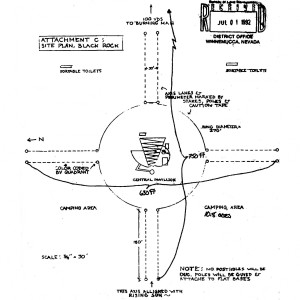
Due to the several hundred mile trip, it was necessary to establish an overnight camp near the Man for the 250 participants who attended. The original form of the camp was a circle. This was not particularly planned, but formed instinctively from the traditional campfire circle and the urge to “circle the wagons” against the nearly boundless space. The following year, an informal plan was required by the B.L.M. for permission to camp. It rapidly developed from a weekend to a week-long event.
Not only was it difficult to find our modest settlement in the expanse, but people exiting our village frequently got lost or mired on the margins of the playa. For practical reasons, four avenues were added, indicating the cardinal directions. Compass headings added to the circle served our need to orient ourselves in that stark emptiness.
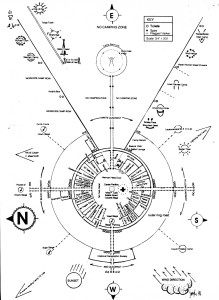
At the urging of founder and director Larry Harvey, a hub gradually developed which centralized services and provided a gathering place. By 1996, a second circle called Ring Road surrounded that. Also, a zone called No Man’s Land was established in front of the settlement to preserve the view of Burning Man. This was lined with “theme camps” and opened outward from the civic plaza at about a 60-degree angle. It extended to a point beyond the Man, and continues to be referenced in a feature of Center Camp called the Keyhole.
Changes
In 1997, Burning Man reorganized, and we made our one-time venture off the playa into nearby Hualapai Valley in Washoe County. Rod Garrett was recruited to create plans and documents for compliance with County regulations. This instituted a lengthy process in developing the basic scheme from which our present city has grown.
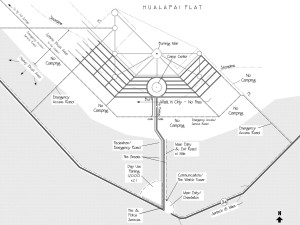
The 1997 plan was to be loosely based on the previous camp-centric schemes, with the Man ancillary to the camp. Additionally, it was to have specified roads and street names, along with other urban amenities. Near to the event, we determined that the land we were promised was not available, and were compelled to shoehorn everything into a strip of private land between the zigzagging property line and the narrow shoreline of Hualapai Flat. The settlement was constrained to an ungainly arc which spread out laterally from the center. This was entirely circumstantial, rather than conceptual, however it unwittingly became a precursor to our eventual design of Black Rock City.
The conditions did establish an external boundary for us. Thick brush and a long irrigation trench bordered the back of the city, fence lines protected our settlement’s flanks, and an impassible isolated playa bordered its front. These natural barriers made it possible to create a secure entry point, a ‘gate’, for the first time.
New Beginnings
We had to work quite site-specifically that year, but in 1998 we returned to the freedom of the totally blank canvas of the Black Rock Desert. This is one of the largest alkali/mud flats on Earth, having an area of about 1,000 square miles.
The new plan was to be strongly affected by our experience of the previous year and the example of 1996, with its disastrous consequence of uncontrolled sprawl. Our goal was to express and abet a sense of communal belonging, and establish population densities that would lead to social interactions. Concurrently, we were attempting to recreate some of the intimacy of our original camping circle, but on a much larger civic scale.
Above all, this city needed to work. It was vital that the flow of people and supplies in, out and within were unimpeded. The layout needed to provide for basic services, and be easily comprehended and negotiated. For continuity, it should incorporate familiar features of the previous event sites, and be scalable for future expansion. It also had to facilitate the art and expression of the community, and support past traditions and the principles of Burning Man.
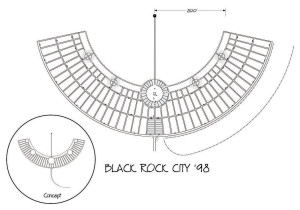
In a conceptual break with the previous camp-centric concept, we arranged the city around a geographic center formed by the location of the Burning Man This position functioned like the fixed point of a drawing compass. From that spot our builders could survey the arc that defined the curve of Black Rock City’s concentric streets.
These streets initially formed less than half a circle and were sub-divided into blocks by a series of radial streets, like spokes projecting outward from the hub of an enormous wheel. Centrally nestled into the populous area facing the Man was the archetypal “Camp Center” of previous years. As with many other cities, a vestige of its beginnings can be found at its heart.
The large figure of the Man became a unique identifier of one’s position by providing a visual bearing at every radial road, even from deeply within the city. We had created an icon and an environment in which it felt as if each participant was co-related — while united by some transcendent principal.
Design Factors
Aside from 1998’s qualitative leap, the current form of our city has resulted from the continuous interplay of many factors: historic circumstance, public safety issues, logistical needs, environmental conditions, politics, social ideals, economic viability, competing or potentially conflicting uses of space within our community, aesthetic perceptions, a need for a kind of spiritual symbolism, and, of course, our own individual inspirations. Rod Garrett has functioned as our city designer, while Burning Man’s chief organizers, representing various departments, have made several significant contributions. In other words, much of the evolution of Black Rock City has proceeded within this scheme exactly as would the development of any other city.
We began zoning space within our city in 1997 because of the need to locate theme camps in some coherent way. Since then we have gone on to designate various special areas, such as Walk-in camping, our airport, DPW and law enforcement headquarters, and large-scale sound installations at the ends of the city. Various issues caused us to create a zone around the Man, within and beyond the arc of Black Rock City, reserved for large-scale art installations. As our plan has grown, we have learned how to differentiate and separate various specialized, and potentially conflicting uses. This involved an empirical study of our social needs as they’ve naturally emerged from an increasingly sophisticated social reality.
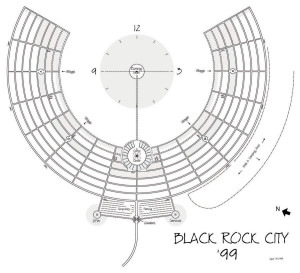
In 1999, we oriented the blocks annularly in order to better provide for future expansion. The theme that year was the “Wheel of Time”. As the radial streets had been laid out in 15 degree increments, we were prompted to name them for numbers of the clock face. When combined with the concentric street names, this turned out to be a conceptually graphic and easy-to-use system of location. Although the theme changes each year, we continue with the time analogy in naming these streets.
By mid-2000, population growth had developed from the once thin line of theme camps along the Esplanade into a thick band, fostering “insider” and “outsider” cliques. In addition, the city had grown vastly, losing the sense of human scale. All this seemed to lead to a vague but general disharmony. In 2005 we decided to affect some social engineering, and the theme camps were rezoned, limiting them to a one block in depth. These narrowly lined the Esplanade, but additionally lined certain radial streets. This defined the borders of several “neighborhoods”, and broke the city down into more comprehensible and homogenous areas.
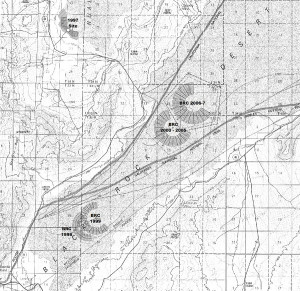
Site
The site of our city has been largely determined by political considerations, along with health and safety issues. During the early 90’s Black Rock City had been deliberately hidden in the desert vastness. Participants were directed to a station called the gate, and here they were provided with coordinates by which they might locate our settlement. As attendance increased, however, it became apparent that large numbers of vehicles could not safely traverse this space. Frequent whiteouts, occasional drenching thunderstorms and the tendency of drivers to accelerate to unsafe speeds in trackless space dictated a location closer to the county highway. Accordingly, in 1998, we sited Black Rock City near the southern end of the Black Rock Desert a few miles outside the town of Gerlach. The subsequent moves to our current location were determined through complex negotiations with the BLM for locations which did not interfere with the needs of other recreational land users.
Additionally, there were unresolved factors of security. The pentagram that marks our city’s external boundary was dictated by (a) the need to minimize our footprint in the surrounding environment due to the concerns of other recreational land users, (b) the economic need to create one controllable entry point at which we could charge an entrance fee (sorely lacking until ’97), (c) the need to protect our community from the depredations of rogue vehicles, and (d) containment for wind born debris (Burning Man being the largest “Leave No Trace” event in the USA).
The most efficient and obvious solution was a circle, but that was unworkable in that it lacked straight lines of sight for security. A triangle or square, while requiring the minimum number of vantages for sight lines, enclosed too much unused space in its angles and created an unnecessarily large perimeter. Six sides or more required too many security points, so the present shape was determined by default.
Aesthetics
The aesthetics were not a large criteria, but were primarily born out of objective process. Oddly, we often found we could judge the practicality of a solution by whether it seemed to “fit”. Angles and distances took on significance; the divisions of space were comprised of sequential round numbered radii and 15° angles, true North ended up 45° off the city’s main axis, and so on. Given the gate approach and the Man’s location, the city’s bi-lateral symmetry provided optimum distribution for vehicular traffic.
As mentioned previously, large artworks were placed in a zone outside the precincts of our city. This was meant to lure participants away from our settlement and into the great silence and open space. Similarly, the open side to the circular scheme of the city takes on spiritual and psychological importance. Instead of completely circling the wagons, we invite the natural world to intrude. We will never further close that arc, as it is humbling to have the vast desert and sky intrude into our self-styled small world. Our hope is that by glimpsing the minute place we occupy in the infinite, we will also sense our unity with it.
Summary
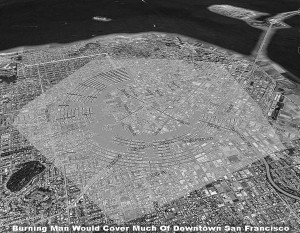
The five annular streets created in 1997 grew to thirteen in 2007, and the arc of our city, originally less than half, now extends to two-thirds of a circle around the Man. A city designed to accommodate 9,000 participants in 1998 developed a capacity for 50,000 in ten years. In 2008, the site covered 5 square miles. If one were to overlay it, our city would cover most of downtown San Francisco.
The city of the Burning Man continues to grow, but though it further develops each year, the plan of 1998 remains the basic framework. This referenced ancient megalithic sites and city-states, as well as various Renaissance and contemporary planning concepts. However, while there may be similarities between this and some current idealized or utopian cities, Black Rock City has a home, a storied history, and a culture to inhabit it, albeit fleetingly. It is at once a very real and yet extremely ephemeral phenomenon, as it must annually arise from nothing, flourish for a few days, and then vanish completely.

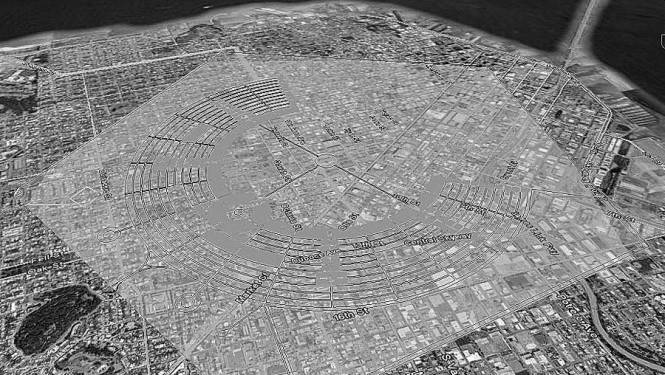
My modest proposal to eject Center Camp:
http://www.flickr.com/photos/tom_2293/3246393743/
Bonus: aerial photos can now be dated to pre-ejection/post-ejection.
Report comment
Very cool article! I had no idea there had been so much change in terms of layout over the last 10 years.
In terms of footprint area, I’m curious to see whether or not a maximum growth boundary will be implemented, similar to Portland’s Urban Growth Boundaries (UGB). Black Rock will inevitably attract more and more people each year and eventually, the decision of when and how to infill to increase density will become an issue that is crutial to the overall success of the event.
Report comment
The one interesting advantage BRC has over any other city in the world is that it can be any shape it wants to be, laid out in any way the organizers want. But what we get year after year after (boring) year is just the same semi-circle with minor tweaks. Adding the keyholes and putting theme camps on the 2 and 3 o’clock spokes are just small changes to what is always the same stagnated design. Yes, the semi-circle works, but with all the space and creativity you guys have at your disposal why not change it up each year? Why not experiment? Why not make things interesting, fresh, and exciting instead of overly familiar? No other city on the planet can do this except for BRC, yet you choose to squander the opportunity. Do you stick with the status quo because it’s cheaper and easier to pull off every year? Because you’re fearful people won’t actually want to EXPLORE the city to see what’s going on there? After 8 burns in a row I haven’t been to Burning Man for that last two because it started to feel like the city and the event had deemed itself “complete” and that no further experimentation in temporary community was needed. I call this stagnation. The playa is a giant blank canvas and yet all you want to do is paint the same picture (with small variations) over and over. That’s lame. Come on Larry, show some originally! Does the Man ALWAYS have to be X feet from center camp? Why can’t center camp be on 6 o’clock and the outer ring road instead of on the Esplanade? Does the temple always have to be x feet away from the man? What if there were two temples? What if the streets were winding instead of gentle arcs? What if you had had 3 or 4 “satellite communities” around the Man instead of one giant curved metropolis; what if you put the temple smack dab in the center of town? Anything, really, would be better then the same old layout with everything where you expect it to be. I get that here in the default world. Burning Man can, and should, do much better at providing a unique experience for its participants.
Report comment
Fascinating story of evolution. I tend to agree with Astronaughty’s call for more creative experimentation with the urban design of BRC, though there are pros and cons.
On one hand, consistency across years means more efficiency with placement of resources, since they’ve been optimized with each iteration to better locate things like potties, emergency facilities, etc. Consistency means being able to re-use much of the plans that have already been drawn up. Consistency also gives you that strange and beautiful feeling when you’re out there, knowing that it’s a completely brand new transient creation, and yet feels like you’re back home in a familiar city.
On the other hand, creative experimentation is at the heart of BM. Personally, I find the geometrically perfect street layout to be too artificial. It reflects a commitment to abstract mathematical symmetry of the blueprint rather than the organic social diversity of the thing itself. The vibrant neighborhoods in old cities have twists and turns, nooks and crannies, boulevards *and* narrow streets, walking paths, bike paths. A real neighborhood gets you lost in it because it’s unique and you have to figure it out. In BRC you get lost because everywhere looks exactly the same as everywhere else.
On balance, I think the BRC layout is efficient and satisfactory, but contrary to the Burner ethos of radical experimentation, and valuing the immediacy of human encounter over abstract and commodified reality. Theme Camps set up along identical streets just recapitulate the capitalistic store-fronts of the default world. We should be aiming more for the self-sufficient villages and cities of the old world, with geometrically unique neighborhoods and plazas. There are certainly creative alternatives to the current city layout that would be just as efficient.
Report comment
I appreciate the above commenters’ desire to be more creative, but I want to add that a linear, sensible layout has one really big advantage: it’s easier to find your way around, especially when your senses are altered and the surrounding neighborhood has mutated into something unrecognizable in the past 12 hours (mobile houses don’t help. ;) ) The spokes of the Wheel of Time and the lettered streets names are easy to remember and navigate. You can continue to conceptualize these things after your spatial location abilities have drifted into the stratosphere.
So I’d encourage predictability on *some scales*, but I also like the idea of letting the villages turn into winding, colorful works of art unto themselves.
Report comment
FEMA people ought to be required to spend a week at BM to see how a city of 40,000, or more, or less, can be run with few internal civic improvements. Think of Katrina after the floods. They had streets. BM has streets. They did not have running water, sewer, electricity, or natural gas. BM has none of those either. Instead of closing down neighborhhoods and putting people in trailers all over the area, FEMA could have brought in portapotties – one per family would keep them well maintained – water wagons with potable water – some people eventually would have had generators for their most essentail appliances, like refrigeration, but till then, ice would do, and repairs could have started immdiately as homeowners, and renters, and landlords, salvaged the homes, while living in them, with a much smaller cost in terms of damage, loss of community, and loss of money.
Report comment
If you are interested, I’d like to point to my response under ‘The City Of Burning Man’ regarding originality in the city design. I appreciate the comments here, but my goodness – “commodified” and “capitalistic” caught me off guard. I didn’t realize the city was such a political statement. The streets and blocks were only meant as a framework, organized to allow individual expression.
Except for the Theme Camps (they need to be territorial), people are free to configure the space within those blocks in any way they wish. There is nothing to prevent “winding, colorful works of art” or “vibrant neighborhoods” there, with all the social aspects involved in creating them. However, if you have experienced the ancient twisted streets of Toledo (not Ohio), or Cairo – you were automatically lost. In the immense space and heat surrounding our event, and with our density and human frailty, facilitating self-orientation is freeing – if not life-saving. The planners try to create a good growing ground, the garden is up to you.
Report comment
Tom (April 28th) raises a point that I have pondered over the years: Density. We’ve now experienced the physical size of the city being reduced, yet the density that participants tend to create remains the same, or seems to, year after year. Certainly this has a lot to do with campsite sizes that are predetermined, but even in sections of the city where the density is pretty much up to the campers it remains essentially the same. I would vote for a somewhat denser experience and maybe that stators with theme camps. There is certainly a point where the vibrancy created by density can also lead to conflict, but BRC is nowhere near that yet.
Report comment
thank you for a wonderful, insightful article! I must agree with loosenut: there is something extremely useful about having a logical layout. I don’t know how many times I’ve given directions on the playa to lost souls, and navigated my way home via landmarks that don’t change (the man is always in the middle!). There is so much to explore and so many other ways to get lost, a little familiarity is a good thing.
Also, not everyone is creatively rooted in the abstract- there are creative souls out there who love geometries and mathematics. Plus, the contrast we get from throwing the two together- limitless creativity brought by participants encased in the strict geometries of the streets- they really set each other off. There are so many surprises at BM if you just change the speed you’re traveling at, stop and talk to people, and explore off the beaten path!
Report comment
Rod, Thank you for the wonderfully detailed description of the origin of our home. I had a wonderful experience in 2004 the only year I have been able to get to the big burn, although I have attended countless minor burns throughout the country. I was on a friends art car which did not have its own sound system. When we were at the Man the surrounding theme camps wonderful blasting music were simply a cacophony. But when were out at the Perimeter Fence by the Listening Tree an amazing thing caught my attention. I could hear each sound installation individually. As I looked at and focused on each one I could hear clearly that particular camp’s music. It was only from that distance (and the open circle design) that I could choose which artist was putting out the beats that I liked best…Of course I was along for the ride and my wishes had little bearing on where our driver (Aptly named Random) headed next and even if I had wished to walk directly to a given party it was likely the music would have changed by the time I got there. And as a sub-note to those who wish experimentation with other layouts I urge you to get involved with your local burns and help develop them, remember its a do-ocracy and the big burn does not have a monopoly on the country’s festivals, also there is nearly a third of the country that is BLM land to experiment with. I love you all and the radical diversity that our culture fosters.
Report comment
Remember that pre-industrial cities evolve organically over centuries, not hours, and have time to alter what doesn’t work. Also, pre-industrial cities often feature promenades, market squares, and other familiar configurations that we may associate with strip-malls and other modern blights. I’m all for experimentation, but the crescent and key placements (the man, temple, center camp, etc) have evolved because they work for most BRC residents. I don’t want the temple in the middle of camp, that would undermine it’s function. Variation for it’s own sake is silly. Let’s innovate with the elements that have NOT yet evolved into a set configuration – what goes on within and between and outside the streets.
Report comment
saw these visions of the future published in popular science. http://www.popsci.com/science/gallery/2010-05/archive-gallery-cities-future
“Henry Ford suggested that instead of migrating to cities, people should industrialize the farm communities they already lived in. Although Ford admired the intellect and technological superiority of urban communities, he lamented their overcrowding and ugliness. His ideal semi-rural city, pictured left, would link neighborhoods around power-supplying dams. Traffic would run underground and city-dwellers would divide their time between farming and industry, depending on the season. ”
The spoke city (image 6) is particularly interesting.
Report comment
After 12 years of participation I will say that Black Rock City is one of the only evolutionary steps that Burning Man has taken which has not metered the advancement of community with the needs of the individuals. As the city grows it becomes more and more difficult to reach a destination, any destination. The depths of the city have become more and more like urban sprawl around the center of the city on esplanade.
Despite efforts to correct this by adding keyholes and now public plazas the effect has been only to make the depth and distance to a destination even less approachable. Traditionally cities have corrected for this with ring roads or boulevards, the inclusion of which could really advance the experience of the ever developing society as a whole. This kind of effective use of throughfarea could actually drive the experience even further into the city while making the distance to a destination less of a burden, and remove much perception of commuting through urban wasteland just to “arrive”.
To add to this, while the distances of travel and depth of the wasteland have only increased it has only become more difficult to accomodate DMV rules and regulations, a lack of integration which makes larger and larger vehicles essential while effectively raising the bar for entry and driving out the less well funded.
Report comment
This is a reply to ic’s comment regarding urban sprawl in Black Rock City. Urban sprawl, as this term is normally employed, refers to uncontrolled growth outward from an urban center. In the real world this is often the result of real estate speculation that leapfrogs over existing settlement, and the result can be distressingly chaotic (urban planners often call this “conurbation”). But we have gradually expanded our city’s footprint in a very orderly fashion, not a sprawling one.
I am frankly a little confused as to what you are actually saying. For instance you observe that, “The depths of the city have become more and more like urban sprawl around the center of the city on esplanade”. If you are referring to street congestion — a very different concept from sprawl – then it is certainly true that increasing numbers of people are drawn to our civic center due to an increase in population. But this hasn’t led to local gridlock, nor has it impeded cross-town traffic. If anything, this has produced higher rates of social interaction: something that any well functioning downtown should do.
I suppose you really mean to say that our settlement has grown, and therefore people are obliged to travel longer distances. You refer to your experience of wandering through a “wasteland “ in order arrive at a point of interest. To me this seems analogous to flipping through television channels in search of a favorite program — all things in between will seem a waste of time. However our experience as planners has led us to value the unexpected and serendipitous as a vital part of urban life. In the default world of mass consumption, our desire to possess a thing displaces our capacity for wonder. But in a city that is chocked with delightful encounter, many have discovered that a journey’s often worth far more than its intended goal.
As to general remedies for traveling longer distances, you observe that, “Traditional cities have corrected for this with ring roads or boulevards”. Such thruways, however, are chiefly useful because they accommodate motorized traffic. I think of the beltway that surrounds Washington D.C. This approach has often led to urban plans that shatter neighborhoods and anesthetize social environments. It really does produce “wastelands”. Look about in nearly any American city and you’ll see this kind of blight. In contrast, we have banned nearly all motorized traffic on our grid. We have created a humanly scaled environment. We like bicycles, we like pedestrians, we do not like unnecessary dust kicked up by speeding traffic, and we love the freedom of a social life that claims the streets.
However, we are not insensible to the fatigues of travel, or to the social deadening created by very long blocks (a classic urban problem). This especially applies to the annular streets at the back of Black Rock City. As the circumference of our city’s arc increases, these streets grow successively longer. More to the point, the space between their intersection with radial streets lengthens. At the outermost reach of the city, this can lead to pretty unrewarding treks.
Over the last few months we’ve been considering an innovative grid plan that could possibly provide a remedy. The idea is to increase the number of radial streets, thus shortening annular block intervals. At the same time this plan would decrease the number of annular streets while increasing block intervals. This reorientation would preserve the area that we allot for settlement, while making thru-traffic inward and outward from the center of Black Rock City more convenient. Overall this plan would also improve sightlines – that is to say the prospect of goal — since straight streets open up a less impeded view than those that curve.
As with any urban planning process this involves several contingent concerns, particularly in the area of theme camp placement, and all of this will be discussed in detail. I mention it here to show that we are mindful of the evolving nature of Black Rock City and that we are very sensitive the immediate experience of its citizens.
Regards,
Larry Harvey
Report comment
Thank you so much for the article. The space issue is important and placement gets harder and harder every year. We are not out there to be lazy, if it takes a little extra leg work to get from a-b, so be it.
Much Love,
Bill Moore (billtron220)
Expansion Mansion
6:30/Cairo
Report comment
I’ve been a participant in our magnificent city since ’99 and think that a few extra radial streets would help-perhaps not at the Esplanade, but a few blocks out, divide by two, then again another couple blocks out. maybe even add diagonals in the outer reaches-make then pedestrian only kinda things. Other than that, please don’t mess with what works. One of the reasons we need to keep it like it is, is for emergency services. How about this- two blocks out, add :15 streets. another three blocks out, they become every :05. most campers in the outer reaches are individuals and small groups, this would increase their access to city center while offering the opportunity to create their own atmosphere within their neighborhoods. It would also make it easier to find your friend-or friend in need- in the outer reaches. “I’m at 3:55 and Emperor” “Oh cool, I’m at 4:15 and Duchess” Whaddya think?
Report comment
After reading IC, i was prompted to write, but then our esteemed default leader chimed in.
Damn, now i have nothing to say!
I’m so happy that we’ve managed to keep certain things the same, while allowing the 9-10 principles to guide us.
For the first time in our history, we, that is our camp, is not on Esplanade. All of us in our camp are committed to making this our best burn ever. Adapting to change makes us all better.
Having a framework to work from, brilliant.
I do wonder if we couldn’t locate the city further out for dust consideration as we are in the throat of a venturi, but understand the problem confronted by a longer drive to the city.
Thank you Rod, thank you Larry, thank you Placement Team! Thank you citizens!
AVIATORS!!!!
Report comment
Hi Everybody, i would just like to make an say hi to everyone at blog.burningman.com
Thank you for keeping us updated. I really appreciate it and find all the information very useful.
Superb post, I found your website via Google. I bookmarked your site for furture infomation, thanks.
Photos On Canvas Canvas Printing Canvas Printing
Report comment
Hi All, i would just like to make an introduction to all the people at blog.burningman.com
Well thats called a neat forum, I never think about reading out an entire list of threads but this message board was successful in getting my attention and believe me, That?s not often.
I was on a digital skirmish for some information and was searching on Google Uganda for it. I visited each of the top 5 pages that came up but didn?t get any relevant result… I then luckily found your diamond forum in the dirt and thought to check it out. This is right what I was after – what a tremendous find!
Thanks ladys and gents at blog.burningman.com and keep your incredible effort up?!?!
Muscle Fuel Mass Muscletech Hydroxycut Hardcore X Tri-Omega EFA Water Bottle Muscletech Creatine Hardcore Optimum Nutrition 100% Whey Gold Meso Tech Cookies & Cream Bar Dymatize Xpand Xtreme Pump 800g
Report comment
I read this article after attending Burning Man for the second time this year. I agree with Larry’s comments that the outer blocks are long, and provide largely unrewarding treks, and that ic’s comments seem to indicate a preference for improving vehicular traffic.
I have a couple of reflections on my experience this year and how the layout of Black Rock City influenced that experience.
1. The Mutant Vehicles are getting out of hand. Most of them are just speakers on wheels with little or no creative value. It’s a subjective statement, but I don’t feel that having 4 or 5 cars parked by the Temple all trying to start their own impromptu rave is all that interesting or fun. My favorite photo of a half-assed art car was a little 2 door sedan with metal flames riveted to the roof. Seriously? That was approved?
2. The above article references the embrace of nature into the city. This year, the deep playa beyond the Temple was both fun to explore because of the variety of installations, and not fun to explore as the city grew towards the end of the week. At some point, we bicycled out to the trash fence beyond the walk-in camping area at the 2 o’clock gate to discover any sort of experience where desert and city merge. In 2009, there seemed to be more space on the playa to walk out and reflect on the city.
3. What is the purpose of the overall them now? How did Metropolis figure into anything in 2010, and for that matter, Evolution last year? I’m not experienced enough to know how it worked in the past, but it seems as though the design of the city has an impact on this.
4. The placement, or zoning, of theme camps, like any good downtown, needs to be reconsidered. I felt like I was wandering through a city trying to pretend it’s something that it isn’t – like Las Vegas trying to pretend gambling is a great family activity.
The authenticity of the city is in its people, and urban planning needs to foster the ability of its people to create spaces that attract and engage other people.
In 2010, the art installations on the playa worked far better than any of the theme camps. Perhaps it’s time to move radically away from the single, large grid, and create small urban centers. A hub and spoke design of villages, loosely connected that create some regional feel at each center.
(and Larry – you came by our camp one night this year looking for Art Car camp, and while one of us did find the map and help you, I think the rest of us, including myself, were completely unhelpful citizens. Regardless of who you were, we should have done better, and the moment stuck with me as being contrary to my ideal for attending the event.)
Report comment
Since the blocks become more loosely filled in as you get further out, why not decrease the radial thickness of each block as the radius increases?
If R is the radius, dR is the radial thickness of a block, and dT is the length of the block, the area of each block is R*dR*dT. So if you want everyone to have the same block area, make dR=A/(R*dT).
Report comment
now my mom in hear singing her audition for sunday’s best.. headphone time :)|GoldenBallerina|now my mom in hear singing her audition for sunday’s best.. headphone time :)
Report comment
Some great thoughts were laid down above! I’m always interested in hearing anothers viewpoint — Thank you!
After reading the article and most of the comments, I’ve come to this CONCLUSION: It’s all really a matter of perception. It’s about the journey along the way. It’s not just reaching the final destination.
Peace be with you and please… continue to enjoy your blessings… be “Happy By Choice”
Burn Brightly!
11:11
Report comment
Rod, thought we never met, my feet have traveled the landscape born of your imagination. I’ve experienced incredible things, and supreme synchronicity with strangers that made profound impacts on my life and perspective. The care you poured into this creation is evident in the flourishing community that continues to grow within it. You will be greatly missed, and I can only hope BRC has someone with at least half the vision, talent, and passion you’ve honored this unique tribe of people with. I know you smiled down on us all this year, thank you for all that you’ve given to us.
Report comment
Comments are closed.